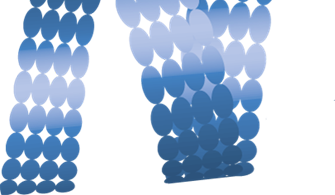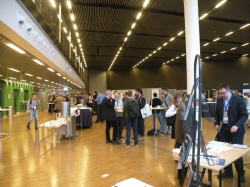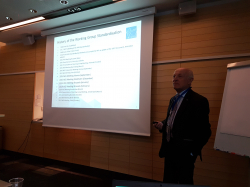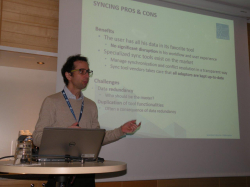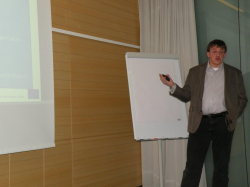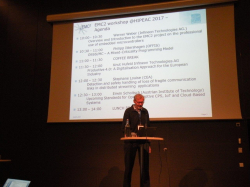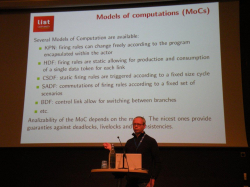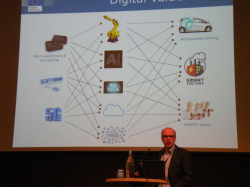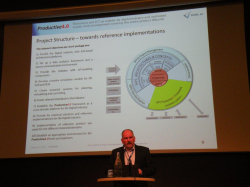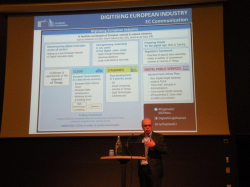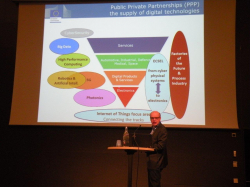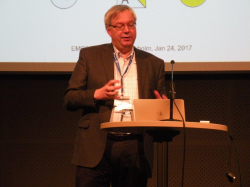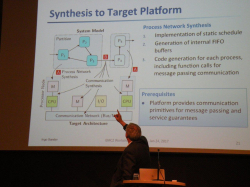- Published on 09 Mar 2017
- Events
CP-SETIS: Development Tool Interoperability and Strategic Standardization Agenda
From 23-25 January 2017, HiPEAC organised the HiPEAC Conference in Stockholm, Sweden. Associated workshops, tutorials, special sessions, several large poster sessions and an industrial exhibition were part of the conference. One of the workshops was from the CP-SETIS project, in which ARTEMIS-IA is a partner.
The goals of the CP-SETIS project are twofold: (a) It will create a sustainable structure to further standardization activities in the area of Interoperability of Systems Engineering Tools, based upon the IOS (Interoperability Specification), a multi-standard that resulted from a large number of past and on-going large-scale R&D projects, and (b) it will update and publish a new version of the ARTEMIS Strategic Agenda for Standardization.
The workshop introduced to the participants the Interoperability Specification (IOS) and its current state, as developed in the most recent finished IOS-project, CRYSTAL. Emphasis was put on the special structure of the IOS, which comprises so-called parts, each of which is a specification for one particular aspect of interoperability within the Engineering Process of Cyber-Physical Systems. These aspects are called ‘Engineering Concerns’. Each IOS part is either (a) based upon an existing standard, if such a standard exists for this particular Engineering Concern; in this case the IOS part typically contains the relevant specifications of this existing standard together with new extensions of that standard to closely fit the specific Engineering Concern; or (b) a completely new specification, if no corresponding standard exists for this particular Engineering Concern; or (c) a ‘bridge’, which are specifications relating other IOS parts to each other. Specifications like the IOS, that comprise a multitude of other standards, their extensions and new specifications, are called Multi-Standards.
The CP-SETIS presentation showed in which way standardization activities for a multi-standard like IOS can efficiently be coordinated and supported, and how these processes will be included in the ARTEMIS Standardization Agenda, complementing the recommendations of the existing Standardization Agenda.
Unlike single-standards, the coordination and support of a Multi-Standard usually cannot be given to a single standardization body, because of the multitude of existing standards involved. On the other hand, coordination of actions by- and information sharing among the different stakeholders is essential, to enable harmonized and goal-oriented progress in both, further extending the Multi-Standard, as well as in driving its formal standardization.
Thus, a supporting and coordination structure is absolutely necessary for the success of a Multi-Standard. CP-SETIS develops the organizational rules for such a structure, which will be called ICF – IOS Coordination Forum, and aims to implement it as an ARTEMIS Working Group in the near future.
After a presentation about the importance of interoperability for development tools and a successful industrial take-up of the interoperability concepts developed within the IOS by AVL, a key industrial partner in many of the IOS projects, the workshop presented the proposed content of the Standardization Agenda.
The main new item in this Agenda will be the handling of Multi-Standards, like IOS. For these kind of specifications, one has to organize two different standardization processes. One of these is a horizontal process about adoption of specifications into the Multi-Standard. Here, a detailed process has been developed by CP-SETIS, in which specifications start as being ‘proposed’ and gradually advance in maturity by an interplay of extension/concretization, application to use cases and evaluation steps, to finally become ‘adopted’. The second process is a vertical one, where for each ‘relevant’ part of the Multi-Standard formal standardization – i.e. the creation of a new standard or the extension of an existing one – is supported and driven by the relevant stakeholders. Not surprisingly, many of the criteria for standardization that have been derived for single-standards in the original ARTEMIS Standardization Agenda, are applicable to the vertical process of Multi-Standards too. In addition, many of these criteria are even applicable to the horizontal standardization process of Multi-Standards. In this way, a high level of uniformity can be reached even for standardization of complex structures like Multi-Standards.
Furthermore, the new Standardization Agenda contains updates and additions about existing and newly emerged standards, recent developments and evolving new paradigms (e.g. cloud computing, agile software paradigms, contract-based development, run-time qualification/certification, open adaptive systems) in generic and domain specific standardization for safety related systems and security-aware safety, particularly in industrial automation and control, automotive and transport, smart everything and IoT.
These changes and additions to the Standardization Agenda were discussed in detail with the CP-SETIS workshop participants. The additional input was gathered and will be included in the Agenda. After discussion of the draft Agenda within the ARTEMIS Working Group Standardization, the Agenda will be published by the end of May 2017.

